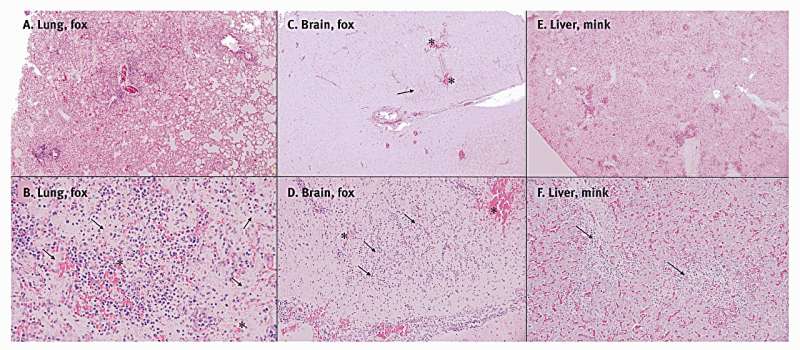This article has been reviewed according to Science X's editorial process and policies. Editors have highlighted the following attributes while ensuring the content's credibility:
fact-checked
proofread
Highly pathogenic avian influenza A(H5N1) outbreak in Finnish fur farms

Between July and October 2023, highly pathogenic avian influenza (HPAI) A(H5N1) was detected in animals on 27 fur farms in Finland. The outbreak, traced to wild birds, revealed significant virus adaptation to mammals. The virus caused severe inflammation in animals' lungs, brains, and livers. Further genetic analyses identified three viral clusters, with mutations facilitating mammalian adaptation.
The outbreak likely originated from extensive exposure of fur animals to infected wild birds, given the high number of wild bird deaths in the surrounding areas. The virus caused a range of symptoms in the animals, from asymptomatic infections to severe neurological disease and death.
Analysis of viral samples revealed mutations associated with increased adaptability to mammals, which may increase the potential to infect humans in direct or indirect contact with infected farmed animals, wild birds and other wildlife, and contaminated fomites or feed. While oropharyngeal swabs were considered for rapid testing during the outbreak, inconsistent results led to a recommendation for tissue sampling in future investigations of suspected HPAI in fur animals.
Direct and indirect transmission of the virus likely occurred between fur animals, contributing to the rapid spread of the outbreak. Further data are needed to fully understand the complex routes and extent of spread between farms.
The findings of the study show that the A(H5N1) virus caused severe disease in infected animals, leading to widespread inflammation in the lungs, brain, and liver. Genomic analysis identified mutations in the virus's PB2 and NA proteins associated with increased adaptability to mammals, which may increase the risk of infecting humans. While no human infections have been reported, it serves as a reminder of the ongoing threat posed by HPAI and the importance of robust surveillance and control measures.
The work is published in the journal Eurosurveillance.
Finnish authorities responded swiftly to the outbreak, implementing comprehensive control measures, including culling infected animals and strengthening regulation on biosecurity requirements on fur farms. These actions contained the outbreak and prevented further spread of the virus.
This outbreak serves as a stark reminder of the risks associated with farming animals susceptible to avian influenza, underscoring the potential for HPAI viruses to pose a threat to human health. The rapid spread of the virus among farmed fur animals and the emergence of mutations that enhance its ability to infect mammals highlight the urgent need for continued vigilance and proactive measures to mitigate the risks posed by HPAI.
Stringent biosecurity measures, robust surveillance programs, and early detection mechanisms are crucial in preventing future outbreaks and protecting both animal and human populations. Virological surveillance designed for early detection of outbreaks, particularly in areas where HPAI is detected in wild bird populations near animal farms, is essential for effective disease control.
This outbreak, with its observed genetic changes associated with increased mammalian adaptation, emphasizes the importance of implementing safe fur farming practices to reduce the risk of future spillover events and the potential emergence of pandemic viruses.
More information: Lauri Kareinen et al, Highly pathogenic avian influenza A(H5N1) virus infections on fur farms connected to mass mortalities of black-headed gulls, Finland, July to October 2023, Eurosurveillance (2024). DOI: 10.2807/1560-7917.ES.2024.29.25.2400063



















